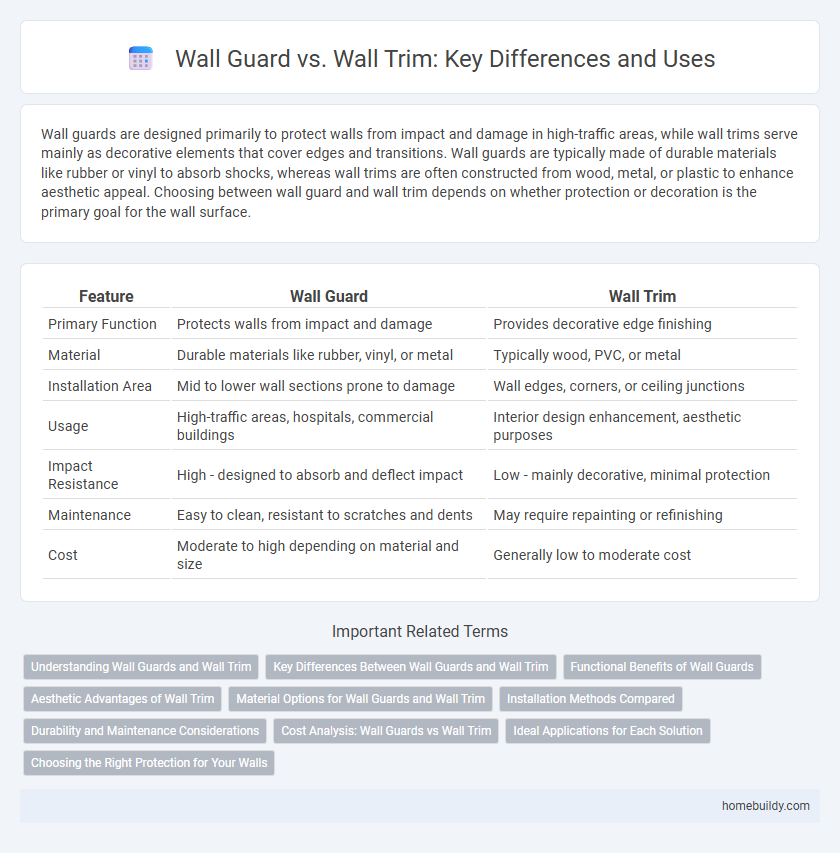Wall guards are designed primarily to protect walls from impact and damage in high-traffic areas, while wall trims serve mainly as decorative elements that cover edges and transitions. Wall guards are typically made of durable materials like rubber or vinyl to absorb shocks, whereas wall trims are often constructed from wood, metal, or plastic to enhance aesthetic appeal. Choosing between wall guard and wall trim depends on whether protection or decoration is the primary goal for the wall surface.
Table of Comparison
| Feature | Wall Guard | Wall Trim |
|---|---|---|
| Primary Function | Protects walls from impact and damage | Provides decorative edge finishing |
| Material | Durable materials like rubber, vinyl, or metal | Typically wood, PVC, or metal |
| Installation Area | Mid to lower wall sections prone to damage | Wall edges, corners, or ceiling junctions |
| Usage | High-traffic areas, hospitals, commercial buildings | Interior design enhancement, aesthetic purposes |
| Impact Resistance | High - designed to absorb and deflect impact | Low - mainly decorative, minimal protection |
| Maintenance | Easy to clean, resistant to scratches and dents | May require repainting or refinishing |
| Cost | Moderate to high depending on material and size | Generally low to moderate cost |
Understanding Wall Guards and Wall Trim
Wall guards protect walls from damage in high-traffic areas by absorbing impact, while wall trim primarily serves decorative and finishing purposes around corners and edges. Wall guards are typically made from durable materials like vinyl, rubber, or metal to withstand frequent contact. Understanding the distinct functionality helps in choosing the right solution for maintaining wall integrity or enhancing interior aesthetics.
Key Differences Between Wall Guards and Wall Trim
Wall guards are designed primarily for protecting walls from damage caused by carts, equipment, or foot traffic, featuring durable materials like rubber or PVC for impact resistance. Wall trim, on the other hand, serves a decorative and finishing purpose, providing a polished edge around walls, doors, and corners, often made from materials such as wood, metal, or plastic. The key difference lies in their function--wall guards focus on protection and durability, while wall trims emphasize aesthetics and smooth transitions.
Functional Benefits of Wall Guards
Wall guards provide superior protection against impact damage, making them ideal for high-traffic areas prone to collisions, unlike wall trims which primarily offer decorative edging. Designed to absorb and deflect force, wall guards extend the life of walls by preventing dents, scratches, and scuffs. Their robust materials, such as vinyl or rubber, contribute to enhanced durability and ease of maintenance in commercial and healthcare environments.
Aesthetic Advantages of Wall Trim
Wall trim offers superior aesthetic advantages compared to wall guards by providing a polished and decorative finish that enhances room design with elegant lines and intricate profiles. Unlike utilitarian wall guards that prioritize protection, wall trim can be customized in various materials, colors, and styles to complement architectural themes and add visual interest. Incorporating wall trim elevates the overall interior appearance, making spaces feel more refined and cohesive.
Material Options for Wall Guards and Wall Trim
Wall guards typically come in durable materials such as vinyl, rubber, stainless steel, and aluminum, designed to protect walls from impact and abrasion in high-traffic areas. Wall trim options often include wood, MDF, PVC, and metal, focusing more on decorative finishes and edge protection rather than heavy-duty impact resistance. Material selection for wall guards prioritizes durability and ease of maintenance, while wall trim materials emphasize aesthetic appeal and versatility for interior design.
Installation Methods Compared
Wall guards are typically installed using heavy-duty anchors or adhesive backings that securely attach to walls, providing robust protection against impact damage in high-traffic areas. Wall trims are generally easier to install, often using simple nails, screws, or adhesive tapes designed for decorative edge finishing rather than heavy protection. The installation method for wall guards emphasizes durability and strength, whereas wall trims prioritize ease of application and aesthetic enhancement.
Durability and Maintenance Considerations
Wall guards offer superior durability compared to wall trim, as they are specifically designed to protect walls from impact and abrasion in high-traffic areas. Maintenance for wall guards is minimal, often requiring only occasional cleaning, whereas wall trim may need frequent repairs or replacement due to its decorative nature and lesser resistance to damage. Choosing wall guards ensures long-lasting protection with lower upkeep costs, making them ideal for commercial and industrial environments.
Cost Analysis: Wall Guards vs Wall Trim
Wall guards generally incur higher upfront costs than wall trim due to their robust materials and protective design aimed at preventing damage in high-traffic areas. Wall trim offers a more budget-friendly alternative primarily used for decorative purposes or minor wall protection, making it ideal for less prone damage zones. Evaluating long-term maintenance and replacement expenses reveals wall guards may provide greater cost efficiency by reducing repair and repainting frequency.
Ideal Applications for Each Solution
Wall guards are ideal for high-traffic areas such as hospitals, schools, and commercial buildings where protection from impact and damage is essential. Wall trims are best suited for aesthetic enhancement and finishing touches in residential or low-traffic environments, providing clean edges and concealing joints. Selecting between wall guards and wall trims depends on the need for durability versus decorative appeal in the specific application.
Choosing the Right Protection for Your Walls
Wall guards offer durable impact resistance, ideal for high-traffic areas prone to damage, while wall trims primarily provide decorative edging and limited protection. Selecting the right protection depends on the environment's risk level; for commercial spaces, polyurethane or vinyl wall guards are optimal due to their shock absorption and easy maintenance. Wall trims suit residential or low-impact zones where aesthetic enhancement is a priority over heavy-duty defense.
Wall guard vs Wall trim Infographic

 homebuildy.com
homebuildy.com